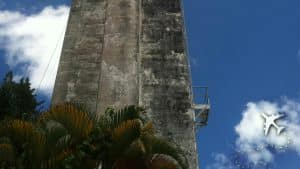Exploring the Arecibo Observatory: A Window to the Universe
Embark on a fascinating journey into the history of the Arecibo Observatory and delve into the groundbreaking scientific research which captured the imagination of stargazers worldwide!

The Arecibo observatory was permanently closed to visitors on November 19, 2020. Early in the morning of December 1, 2020, the 900-ton suspended main telescope catastrophically collapsed onto the reflector dish below. Rest in pieces (RIP)
The Arecibo Observatory was home to the world’s largest single-aperture telescope located in the center of Puerto Rico. It did super-cool things like collect data for the SETI@home project and functioned for use in radio astronomy, atmospheric science, radar astronomy, not to mention allowing E.T. to phone home.
Its remoteness in the RF-free mountains of the Caribbean makes it perfect for use in exploring space, but was a pain in the ass to visit. My 2012 journey to the observatory took 90 minutes from San Juan through the mountains and jungles of Puerto Rico encountering plenty of chickens, goats, and the (sometimes) paved roads.
The loss of cellular service gave a good indication that I was close to the observatory. Once I began seeing signs requiring all visitors to turn off cell radios, and two-way radios. The remainder of the journey was pretty easy, thanks to the marked road signs.
Through the viewfinder
Arecibo Observatory Uncensored
Once I arrived at the visitor center, there were no lines or waiting. The facility wasn’t a very popular tourist destination due to the fact you just drove to into the mountains to (what it seemed like) a third-world country.
The visitor center was very average with lots of nerd information about the observatory, astronomy, and access to overpriced gift shop stuff.
Just outside of the observatory building was a ledge overlooking the 1000 ft diameter radio telescope that humans created to explore the furthest reaches of space. Standing on the ledge and overlooking this gargantuan reflector dish was breathtaking.
Unfortunately, the funding for the Arecibo Observatory was drying up, leaving its future uncertain. Sadly, on December 1, 2020, the 900-ton suspended main telescope came crashing down through the reflector dish below. Because of the way the suspension cables snapped during the failure, most of the facility (telescope, reflector dish and the supporting towers) were partially or totally obliterated.
This event, coupled with the decreased funding effectively killed the Arecibo observatory – ending an era in space exploration.
Frequently Asked Questions
The Arecibo observatory was permanently close on 11/19/2020 and remains closed today. Visitors to the site will be turned away at the gate.
Due to the lack of funding and advancements in other technologies there are no plans (as of the date of this article) to rebuild the Arecibo Observatory.
The reflector dish was 305m (1000ft) in diameter before it was destroyed by a mechanical failure on 12/1/2020.
Failure analysis determined that failure of multiple cables breaking or pulling away from their respective spelter sockets caused a catastrophic shift in load distribution which led to a cascading failure and collapse of the structure.
Natural World – Puerto Rico: Island of Enchantment (1983), GoldenEye (1995), Species (1995), Contact (1997), Encuentros (2003), Naked Science (2004), Human Universe (2014).
Everything you need to know before you visit Arecibo Observatory
CURRENT WEATHER
overcast clouds
AIR QUALITY
Moderate
GPS COORDINATIONS
18.3442, -66.7526
HIGH SEASON (MOST EXPENSIVE)
December – April
LOW SEASON (LEAST EXPENSIVE)
May – November
Exploring the Arecibo Observatory: A Window to the Universe
Sean's uncensored review of the Arecibo Observatory in Puerto Rico.






